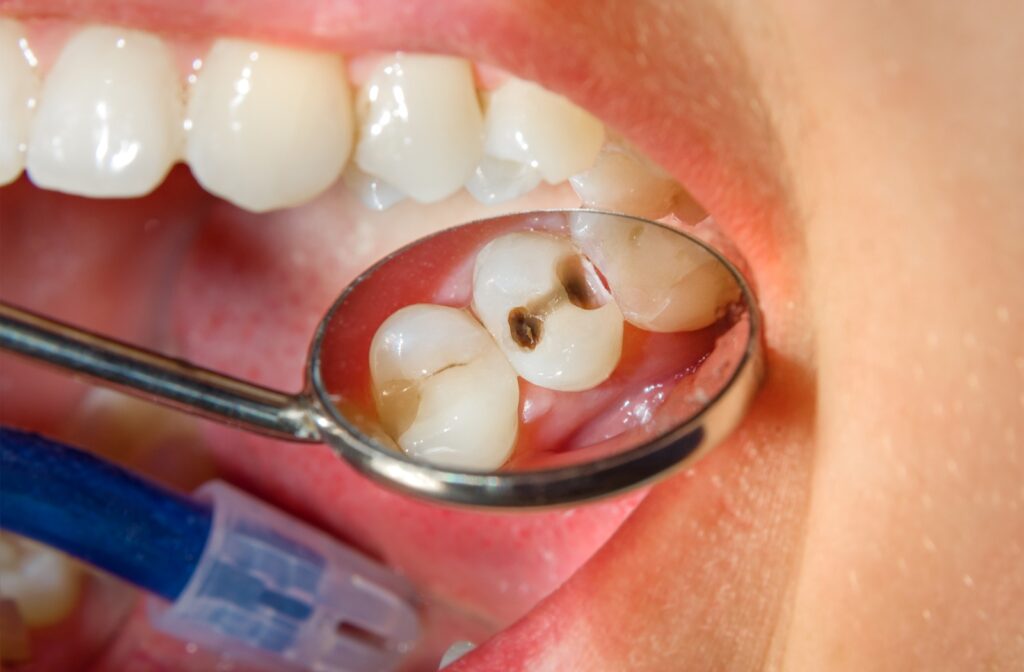Cavities are common conditions your dentist can treat, but how do they do this? Your dentist has several ways to address tooth decay effectively with today’s technology. No matter the severity, your cavity can be dealt with.
Continue reading to learn more about how dentists fix cavities, including the different procedures available.
How Do Cavities Develop?
A cavity is a small hole that develops when acids eat away at the outer layer of your teeth, known as your enamel. They are permanently damaged areas of your tooth that result in several symptoms, including:
- Toothache or spontaneous pain
- Tooth sensitivity
- Mild or sharp pain when eating or drinking
- Visible holes in your teeth
- Brown, black, or white staining on the tooth’s surface
- Pain when biting down
Cavities develop with time due to poor dental hygiene, such as not brushing your teeth well enough. Plaque, a sticky, clear substance, forms when bacteria feed on sugars and starches in your mouth. It eventually hardens, becoming tartar, which is harder to remove.
The acids present in plaque remove minerals from your tooth enamel. This erosion creates the beginning of a cavity, and bacteria then penetrate further into your tooth.
Tooth decay continues until it reaches the inner parts of your tooth. This area of the tooth, known as the pulp, will swell and cause pain.
The Risk Cavities Present
Cavities can seem insignificant, but they can result in serious complications. Some issues associated with cavities include:
- Pain
- Swelling or pus around affected teeth
- Damaged or broken teeth
- Chewing problems
- Shifted teeth after tooth loss
An untreated cavity can lead to a tooth abscess, a pocket of pus caused by a bacterial infection. Abscesses are only treatable with the help of your dentist, who can drain them and remove the infection. For more severe cases, they may need to extract your tooth.
A tooth abscess can lead to serious or life-threatening complications if not treated in time. With the risk cavities can have on your health, how do dentists deal with tooth decay?

How Do Dentists Fix Cavities?
Your dentist has several treatments at their disposal to help fix a cavity. The one they use depends on the severity of your tooth decay. Some treatment options include:
- Dental fillings
- Crowns
- Root canal
- Solea laser
Dental Fillings
A dental filling is a common way to treat cavities before they become infected. There are many kinds of fillings available today, both metal and tooth-coloured, which help fill in the damaged areas of your tooth.
Depending on the material used, your procedure may have some extra steps. The overall filling process includes:
- Using an anesthetic to numb the affected area
- Removing the decayed parts of the tooth
- Testing the area to ensure decay is gone
- Filling the tooth with the chosen filling material
- Finishing & polishing the tooth
Crowns
A dental crown is a tooth-shaped cap. It covers a natural tooth to help restore shape, size, and strength. A crown is ideal when a decayed tooth becomes too weak and may break.
If you need a crown, your dentist completes this procedure in 1 to 2 visits:
- Examination & preparation: Your dentist will assess the damage before reshaping the tooth to hold your future crown, creating an impression in the process
- Receiving the permanent crown: Your dentist will have your permanent crown ready for use & will cement it in place if the fit is ideal
Root Canal
A root canal is necessary when a tooth is severely decayed or infected. Your dentist removes the nerve and pulp of the tooth during this procedure.
The following occurs during a root canal:
- An administered anesthetic to help you stay comfortable
- The drilling of the abscess to help remove the pulp, bacteria, & decayed nerve tissue
- The cleaning of the tooth with root canal files & fluid
- The sealing of the tooth
- The filling of the tooth’s interior
- Further tooth restoration if needed
Solea Laser
The Solea laser is a CO2 dental laser system that replaces the standard dental drill used in many procedures. It speeds up the dental process and is helpful for patients who have dental anxiety.
For the average patient, the Solea laser means:
- No anesthesia, needles, or post-appointment numbness
- No bleeding
- No loud or uncomfortable drill
- Fewer & shorter appointments
The majority of patients don’t feel discomfort with the Solea laser. This laser can help your dentist prepare your tooth for a cavity filling without the need for any prior anesthetic.
Your dentist has many ways to treat a cavity, no matter the severity. However, the best way to deal with cavities is to prevent them from developing at all. You can lower your risk of cavity development in several ways.
How Can You Prevent Cavities?
Prevention is your best defence against cavities. You can reduce your risk by:
- Brushing your teeth twice a day
- Flossing at least once a day
- Eating less sugary & acidic foods
- Limiting snacking between meals
- Visiting your dentist regularly
If you have symptoms of a cavity, visit your dentist as soon as you can. You may feel fine, but tooth decay can become a significant problem with time. If you need a cavity fixed, contact your dentist today.




